Insect & Disease Conditions Update
The growing season is in full swing with temperatures rising and plenty of sunshine (although many parts of Maine could use some rain). This has led to an acceleration in tree growth and development and an increased incidence of insect and disease issues. All of us at the lab and technicians around the state are busy making technical assistance visits, and coordinating and conducting various insect- and disease-related programs. To add to this busy time, we currently do not have an office manager to answer phones, distribute inquiries to the appropriate people and help with logistics. We assure you that we are doing our best to manage the high call and request volumes that come with summer, but ask for your patience for the time being. We will be available for help and information, it just may take a bit longer than usual. As always, you can reach us with concerns or observations about forest health via our tree ailment form.
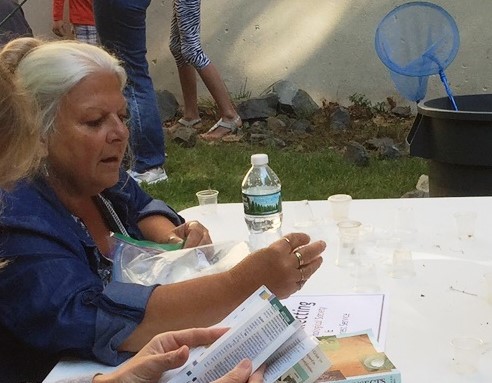
In the rush of the spring season there has been a lot of changes in staffing in the Forest Health and Monitoring Division (FHM).
Patti Roberts joined her husband in retirement on May 29th. Patti made an immediate impression on our group. Less than two months after she joined the Maine Forest Service we wrote in the May 2014 Conditions Report “Patti has taken everything we’ve thrown at her in stride—storing her lunch alongside entomology and pathology samples in the fridge, gamely counting the carpenter ants she squashes (even those bold enough to venture across her desk), handling contracts (and negotiating for us), and properly stowing browntail moth webs and pole pruners. We’re impressed by her enthusiasm, and think you will be too.”
Her willingness to embrace the quirks that came with working for FHM (beyond the carpenter ants marching across her desk) and our respect for her work and attitude grew. Patti became an important part of our division, bureau and department. We wish Patti and Dean all the best in retirement, but we sure do miss her. Image: Patti helps identify a sample at a Bug-Maine-ia event. Maine State Museum.
Bryan Way has transferred from his Conservation Aide position to an Environmental Specialist with the Land Use Planning Commission. All will miss Bryan’s enthusiasm and knowledge. Entomology Technician, Jason Saucier, has decided to leave his district in Northern Maine to pursue other opportunities. We would like to wish Bryan and Jason well in their future endeavors.
Jenna McMinn and Josephine Miller have accepted summer internship positions, and both will be returning to the University of Maine this fall. They will be aiding with survey and trap deployment for programs such as hemlock woolly adelgid, emerald ash borer and forest inventory throughout the summer field season. Jenna and Josephine started May 18 from the Old Town Regional Office.
Lauren Keefe also started on May 18 in a Conservation Aide position with the Forest Inventory Unit. Lauren has completed her Bachelor of Science in Forestry from the University of Maine.
Jeff Harriman accepted the position of Resource Management Coordinator for the Division vacated in 2019 with the retirement of Mike Devine. Jeff has been with the Division for more than 20 years and brings knowledge of the full workings of the Forest Inventory Unit and a firm grasp of many of the programs within Insect and Disease Management. We look forward to working with Jeff in this new role.
|
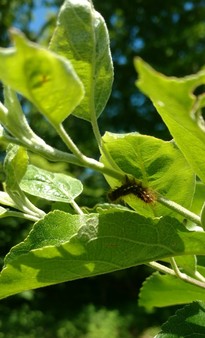
Browntail Moth (Euproctis chrysorrhoea) – Although the weather in May and June has been quite pleasant for enjoying the outdoors, in areas impacted by browntail moth, these conditions are detrimental. Trees severely defoliated during this period and those severely impacted during the last growing season may experience long term impacts that affect their health. The dry weather also impedes development of the fungus Entomophaga aulicae which attacks browntail moth (BTM). Despite this we have reports of continued impacts from last year’s outbreaks in the Casco Bay through Merrymeeting Bay region and have confirmed the fungal disease in caterpillars in Washington (Knox County) and Montville and Liberty (Waldo County).
A special thank you to arborist Chris Everest and our own Aron Bishop as well as others who have been reporting failed BTM winter webs and those who have been keeping an eye out for and reporting other disease activity. We encourage people who see diseased caterpillars to report them via our survey.
We continue to monitor developmental plots and have been giving updates to the public on social media. During the 3rd week of May, BTM caterpillars from Turner, Harpswell and Portland had developed into the 4th instar. This is the life stage during which the caterpillars develop the irritating hairs. During the last week of May, caterpillars had developed into the 4th instar at all monitoring sites from Lincolnville south to Portland and west to Turner. Beginning in the last weekend in May caterpillars had started to wander, increasing the call volume as concerned residents encountered them on their houses and decks. Some pupation has started at all of the monitoring sites visited the week of June 15. A reminder, the filmy cocoons surrounding the pupae contain the last cast skin of the caterpillar and are full of toxic hairs. Many people become exposed to the hairs through encounters with the cocoons.
Be sure to check out the FAQ page which has a lot of great information on this tree and human health pest.
Image: Later instar BTM caterpillar infected with Entomophaga aulicae at Lake St. George in Liberty ME. MFS
|
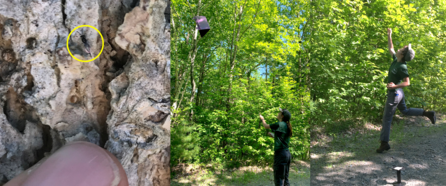
Emerald Ash Borer (EAB) (Agrilus planipennis) – We are approaching the time when emerald ash borer (EAB) adults will be emerging from ash trees throughout much of Maine. According to degree-day maps, which calculate the accumulated temperature needed for an insect to develop, EAB is already starting to emerge in the southernmost of Maine, with central and coastal Maine not far behind. A link to a degree day map for emerald ash borer is available from www.maine.gov/eab under Surveillance, Outreach & Involvement. A good rule of thumb is that when black locusts start to bloom, EAB is about to emerge and start its flight season.
Coinciding with the emergence of EAB adults is the release of parasitoids that attack and kill EAB eggs and larvae. Last year we released EAB parasitoids in northern Maine and the focus this year will be to perform releases at infested sites in southern Maine. Tetrastichus planipennisi is a tiny endo-parasitoid, meaning it lays its eggs inside EAB larvae where they develop and eventually kill the EAB host. These are being released at five sites in York County. Although they are not likely to save ash trees which are standing now, there is some evidence that they will help protect the next generation of ash trees that grow up in the ‘aftermath’ forest.
Also coinciding with the emergence of EAB adults is the hanging of purple prism traps (PPTs). Just over 200 PPTs were deployed in Maine for the 2020 EAB flight season with trap hanging finished on June 17. Traps are checked twice per season, once when lures are refreshed mid-season and again when traps are removed for the season, to see if any adult EAB have been caught in the glue coating the trap surfaces. This program helps us to monitor the spread of EAB and detect new and unknown infestations early on that could otherwise go undiscovered for years until significant damage has already occurred. Images: Emerald ash borer parasite, Tetrastichus planipennisi (left); Intern Josephine Miller deploys a purple trap (center); Intern Jenna McMinn tosses a weighted line to bring a purple trap into the canopy of an ash (right). MFS
|

Euonymus caterpillar (Yponomeuta cagnagella) – One positive outcome for FHM in regard to Covid-19 work changes is that our Conservation Aide in Augusta, Amy Emery, put some extra time at a computer to good use by compiling an index of past Conditions Reports. That work has shed some light on this species.
In 2017, the caterpillar was reported as Yponomeuta spp. on lilac in Hebron. A repeat visit to the site a year later revealed the primary host was actually European spindle-tree (the lilac was infested due to complete defoliation of the spindle-tree). Amy’s work has allowed uncovering of our first report of this species in Maine, which was in June 1990 in Woolwich. By July 1990, we could report it was found to just west of the Penobscot River from the New Hampshire border, and there was a much better understanding of just where European spindle-tree was planted in Maine.
This insect was quiet for some time; reports faded in 2000 and did not resurface until 2017.This year, we’ve fielded reports from Freeport (Cumberland County) and Orono (Penobscot County) and the University of Maine Cooperative Extension has also received several reports.
The good news is that Euonymus caterpillar is not associated with significant damage to native trees or shrubs. Even on its primary host, damage is often insignificant, if not the preferred aesthetic. Caterpillars are now finishing up feeding and pupating within large volumes of silken webbing. Adults will emerge in July and lay eggs on the stems of host trees. Those eggs will hatch and larvae will overwinter under a protective coating on the host.
Management is possible using foliar application of a product effective against caterpillars just after leaf expansion such as an early spring application of BtK. During the 1990s, it was reported that some opted to manage this pest through cutting back the infested Euonymus. Image: Euonymus spp. and other plants festooned with the webbing of Euonymus caterpillar, Orono, ME. MFS
|
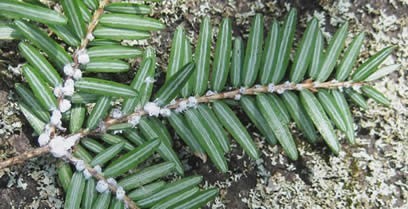
Hemlock Woolly Adelgid (HWA) (Adelges tsugae) – Hemlock woolly adelgid has recently been found in the town of Mount Desert on Mount Desert Island. At this time, we have only found it in a fairly limited area west of Long Pond, but it is a fairly cryptic insect and can be hard to detect at low levels. We encourage people on Mount Desert Island and in all areas within 60-100 miles of the coast to watch their hemlock trees for signs of HWA and contact us if you think you see it.
The HWA quarantine was expanded earlier this year and encompasses this new detection. Hemlock branches or chipped material with branches leaving the quarantine area needs to go to a facility with a compliance agreement to receive regulated hemlock. Contact Mike Parisio with questions about this and other forestry quarantines. Michael.Parisio@maine.gov or (207) 287-7094. Image: Hemlock woolly adelgid on hemlock twig as it would appear in fall. MFS
|
Spruce Budworm (Choristoneura fumiferana) – As we cruise into mid-June, Maine Forest Service field staff and our network of cooperators all over Maine will soon be busy hanging pheromone traps as part of our long-term spruce budworm (SBW) monitoring program. Despite the small size of these moths, huge populations of this native defoliator have the potential to cause severe and widespread damage during periodical outbreaks. At this time of year, we are quickly approaching the part of the life cycle where SBW takes on its most damaging form as a mature larva. Even though we’re already well-aware from last year’s monitoring activities that we had elevated numbers of SBW moths in Maine in 2019, overwintering larval surveys told a slightly different and more-favorable story in terms of limited reproductive success. Therefore, it remains to be seen whether or not this is the year when we finally begin to see visible defoliation damage from SBW in Maine, which we know is present just beyond our border in portions of neighboring Quebec and New Brunswick. As SBW larvae feed, partially-consumed needles are left loosely clumped together at branch ends with webbing, serving as protected feeding sites for SBW larvae throughout their development. Once these severed needles desiccate and become discolored, trees with significant feeding damage will develop a distinct overall hue ranging from gray to reddish, usually becoming most apparent in July. We encourage any of our readers who live, work or recreate in northern Maine to report any areas with extensive evidence of SBW feeding damage. By the time the SBW larvae are done feeding and begin to pupate in late June and early July, pheromone traps will already be in-place at 350 sites throughout Maine’s spruce-fir forests, ready to intercept adult moths as they emerge in search of a mate from July through August.
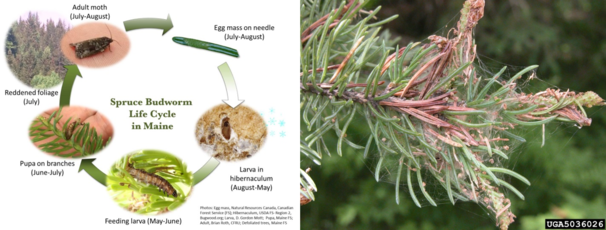 Images: (above left) General spruce budworm life cycle in Maine, MFS; (above right) Typical spruce budworm larval feeding damage illustrating clipped needles webbed together at branch tips. Joseph OBrien, USFS, Bugwood
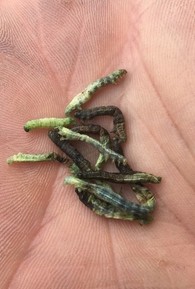
Winter moth (Operophtera brumata) – Maine Forest Service staff collected winter moth caterpillars from various sites along the southern coast of Maine to determine if prior releases of Cyzenis albicans, a parasitoid fly of winter moth, have led to their establishment. On June 9th caterpillars were collected from Kittery, Cape Elizabeth, South Portland and Harpswell. These collections allow for determination of the parasitism rate in each population and collection of C. albicans for use in future biocontrol releases. C. albicans is very host specific and only parasitizes winter moth, leaving our native species alone. The collected winter moth will be reared to pupae and then delivered to the Elkinton Lab at University of Massachusetts to determine the rate of parasitism. Parasitoid pupae will be returned to Maine to be released at new biological control sites.
We have received reports of severe winter moth defoliation in a few locations, particularly in Boothbay Harbor and in Kittery. We have also received many calls from Kittery reporting winter moth damage, however when we collected there, we saw many caterpillars that looked as if they had died from infection by a pathogen. This is both good and bad news: good news for winter moth reduction but bad for the parasitoid C. albicans, as it also dies when the caterpillar succumbs to these infections. Image: Dead winter moth caterpillars in Kittery. MFS
|
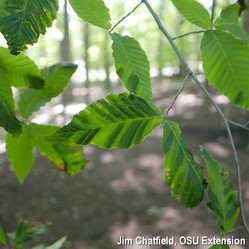
Beech Leaf Disease – Recent surveys for beech leaf disease (BLD) in states to the west of Maine have found that the disease is more widespread than previously thought. BLD has not been found in Maine, and much is still being learned about this very new disorder found in Ohio in 2012. It seems that all beech trees are susceptible to BLD, including European and Asian species (this includes beech cultivars available in the nursery trade). While mature trees are seldom severely affected, impacts to understory beech can be severe, leading to attack by secondary agents of decline and mortality. The combination of factors and organisms that lead to BLD is not fully understood. So far, a microscopic roundworm (a nematode) has been consistently associated with symptoms, but the role of the nematode and other microorganisms in the disease complex is not yet clear.
BLD symptoms include:
- dark-green striped bands between lateral leaf veins and reduced leaf size.
- the banded areas of leaves may be leathery,
- leaf curling
- premature leaf drop
If you see symptoms like those described and pictured here, please contact MFS forest pathologist, Aaron.Bergdahl@maine.gov, (207) 287-3008. Image: Jim Chatfield, OSU.
|
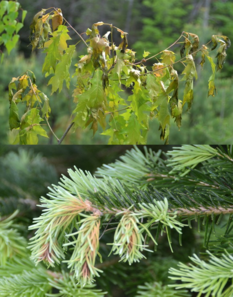
Frost Damage – Frost damage was recorded on multiple tree species in multiple locations in Maine. This seems to have resulted from some cold nights in May. In some locations, oak and ash were hit particularly hard and experienced large amounts of leaf loss. There was also heavy damage to seedlings/saplings, in some cases leading to mortality of small seedlings. In these affected locations, young tissues were at stages very vulnerable to frost. In other locations where leaves were more developed, strange discoloration occurred that may have resulted from this exposure to low temperatures (for example, chlorosis in ash and reddish leaf coloration in oak). In areas where conifers had already broken bud, this new succulent tissue was lost to the frost, while in other areas where phenology was delayed, conifers were not affected. In many cases, more mature trees will push out new leaves, although the leaves may be smaller making crowns appear thin. This event is not anticipated to result in any persisting tree health issues. Image: (top) Wilting and discoloration of oak leaves due to frost injury; (bottom) damage to newly emerged fir needles – these will eventually dry out and become dark and brittle. Maxwell McCormack
|
Proactive and Preventative Cultural Practices Toward Disease Prevention – Since it has been dry for much of the spring in many parts of Maine, the insect and disease lab has not been getting as many reports of moisture-related leaf and needle disease as in previous years For example, last year the lab was busy responding to calls about anthracnose diseases of ash, oak, maple and sycamore, apple scab, spruce needlecasts, pine needle blights and others. However, just because natural conditions favoring these diseases aren’t occurring, irrigating landscapes regularly during these dry times can artificially create optimal conditions for several leaf and needle diseases and aid in the dispersal of other fungi harmful to your landscape. Fungi need moisture for spore production, spore dispersal, spore germination and infection of trees and shrubs. Anything that can be done to reduce the period of time that leaves are wet will decrease the chance for infection of most common leaf and needle diseases. Here are three tips for reducing the risk of fungal diseases in your landscape trees and shrubs:
- Reduce the source of new infections (inoculum) as much as possible via winter pruning of dead and diseased wood, fall and spring clean-up of leaves and in serious instances, applying preventative fungicide treatment (make sure composted leaves are covered with grass clipping or dirt to prevent fungal spore dispersal);
- Irrigate at night when high relative humidity conditions already occur;
- If possible aim irrigation water so that it does not directly hit the foliage of trees and shrubs;
- Manage weeds that grow amongst your trees and shrubs to increase airflow/aid in drying of foliage (reducing the period of leaf wetness) – this especially important under conifers where weeds and grass can grow into the lower crown where needlecasts and blights often start.
When thinking about disease prevention in a landscape setting, a general concept to remember is that three things are needed for disease to occur: a susceptible host, a pathogen able to infect that host and the proper environmental conditions for infection. By eliminating one of those three components, disease will not occur. We tend to not want to exclude the host, because it is likely what we are trying to protect, it is difficult to exclude pathogens that we cannot see that may be abundant in the local environment. Finally, while we cannot control the weather, we can influence moisture conditionals in the way described above and limit disease. By implementing preventative cultural practices and supporting tree vigor we can support our trees’ resistance to many common native diseases.
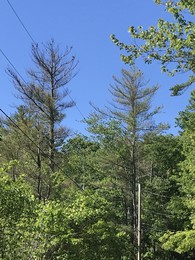
White Pine Needle Diseases – The white pine needle disease (WPND) complex has been impacting eastern white pine trees for more than 12 years and is continuing this spring/early summer 2020 across Maine’s white pine resource. This is due to the abnormally wet weather in spring 2019 which led to higher rates of infection followed by severe symptoms in many areas of Maine in early summer 2020. Remember, in the life cycles of these diseases, spores infect newly emerging needles during wet periods in spring. These infected needles show no symptoms until the following spring/early summer when the infected needles turn yellow, the fungi infecting the needles produce spores that initiate new infections before being prematurely dropped. So, despite the dry weather this year across much of the white pine resource, severe symptoms may be seen this year. However, with any luck, next year the trees may get a break after years of disease. Reports of severe yellowing of eastern white pine needles have already been received from southwestern Maine. In areas further north, where tree phenology is at an earlier stage, symptoms and disease development are being closely monitored. Current observations indicate that white pine in Central Maine are likely to display severe yellowing symptoms in late June followed by severe early defoliation due to heavy infection levels by the fungi that cause white pine needle damage. Image: Severe white pine needle disease symptoms in 2020 in southwest Maine. Isabel Munck, USFS
|
Forest Operations Notifications Going All Online in January 2021
For over 30 years, the Forest Operations Notification (FONS) system has been paper-based. Landowners and managers submit paper copies to the Maine Forest Service (MFS); data is entered by hand; acknowledgment letters printed and mailed; FONS filed, etc. Repeat the process with amendments. Then paper copies of landowner harvest reports are sent out at the end of the year. More paper, more data entry, more filing. That’s all about to change.
Starting in January 2021, FONS will become Forest Online Resource Tool (FOResT), and it will be all online. Landowners, Designated Agents, Foresters, and Loggers will need to create individual accounts in FOResT to participate in harvest notifications.
MFS currently is testing the system with a small set of users to identify and fix glitches before the system goes fully live. We will continue to offer additional information, including how-to videos, as the year progresses.
For now, you don’t need to do anything different. Just be aware that paper FONS are going away soon.
Office hours are 7:30 am to 4:00 pm, Monday through Friday, except for holidays. However, we are currently working remotely and DACF buildings are closed to public access. You can still reach us at: (207) 287-2431. Status of the building closure will be updated on the DACF homepage, www.maine.gov/dacf.
NOTE: The Augusta office is now housed in the Deering Building, 90 Blossom Lane, Suite 201. The mailing address and phone numbers are unchanged. A map is available on our website. The lab at 50 Hospital Street is currently housing the Kennebec County Soil and Water Conservation District.
Conditions Report No. 3, 2020
On-line: https://www.maine.gov/dacf/mfs/publications/condition_reports.html
Department of Agriculture Conservation & Forestry
Maine Forest Service – Forest Health and Monitoring Contributors: Aaron Bergdahl, Allison Kanoti, Mike Parisio, Thomas Schmeelk, and Colleen Teerling
Unless otherwise noted, photos by Maine Forest Service, DACF
|